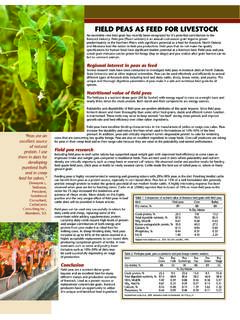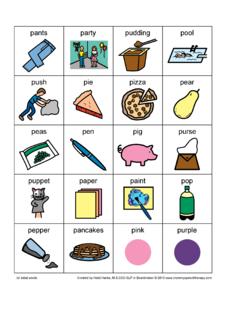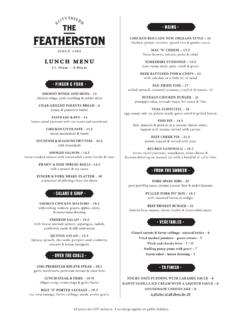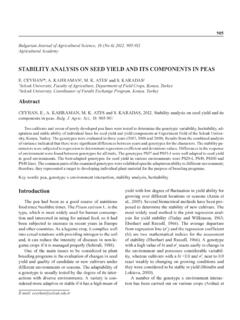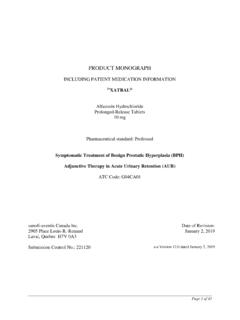Transcription of FIELD PEAS MAKE EXCELLENT QUALITY FORAGE FOR BEEF …
1 FIELD PEAS MAKE. EXCELLENT QUALITY FORAGE . FOR BEEF CATTLE. Vern Anderson, , , and Breanne Ilse, M. Sci. We know that FIELD peas are a highly palatable grain for all classes of livestock and are a nutrient dense energy and protein source. Less well known is the nutritional value and palatability of FIELD peas harvested as FORAGE . FIELD peas or the popular FIELD pea-cereal grain mixes can be harvested as hay or silage early enough in the cropping year to potentially allow for a second later season crop. Winter wheat following pea FORAGE is a logical and popular cropping sequence. Conversely, pea seed left in the FIELD after harvest that is lightly tilled in, may grow enough in the fall to harvest FORAGE by grazing animals or Dr. Anderson possibly harvesting the crop as silage. FORAGE trials at the Carrington Research Extension Center (Table 1). indicate peas make EXCELLENT QUALITY hay when harvested alone with a relative feed value of 146 with nearly 17% protein.
2 Growing mixed stands of peas and oats or barley for FORAGE increased hay yields from tons per acre for straight peas to tons for oat- or barley-pea mixes. The true test of the value of FORAGE is measured in animal performance, The cattle really with the QUALITY of FORAGE being more critical in young animals. Trials at like pea-oat silage. the NDSU Carrington Research Extension Center compared pea hay, pea-barley hay, pea residue, and grass It has been easy to hay as the control in rations for weaned steer calves fed to market weight. A two month growing phase include ~30% FORAGE in 55 Mcal NEg rations followed by a month finishing period with ~15% FORAGE in start the cattle on the 62 Mcal NEg rations. The rations included barley, corn, and distiller's grains as well as appropriate feed compared with supplements. Calves tended to eat more of the pea hay and pea-barley hay rations just after weaning. last year when the Gains during the growing phase strongly favored the pea hay and pea-barley hay diets by and diets were corn pounds per day over the grass hay diet.
3 The advantage during finishing was reduced as there was less silage based. FORAGE in the ration. Feed efficiency tended to favor all the pea FORAGE diets. Carcass traits were similar but the percent choice in the two pea FORAGE diets was 79 and 82 percent compared to 67 and 60 in the Sebastian Estrada, control and pea residue rations. Meyer Ranch, Morristown, SD. Based on the improved animal performance in growing calves, pea hay is worth 230% of grass hay. Pea hay is worth $ per ton if grass hay is valued at $75/ton, or $395 gross return per acre. Pea-barley hay is worth 160% the value of grass hay or $120 per ton which equates to $307 per acre gross return. Pea FORAGE harvested early in the season may allow a continued on page 2. Table 1. FORAGE production and nutritional value of FIELD pea and/or cereal grains* (3yr avg). DM Yield Hay Yield Silage Yield Protein TDN. Tons/acre 15% Moist 40% DM % % RFV.
4 FIELD Peas Barley FIELD Peas/Barley Oats FIELD Peas/Oats *adapted from S. Zwinger, Carrington Res Ext Center Annual Report, 2011. continued from page 1. second crop of FORAGE or possibly sunflowers. Peas will improve soil tilth and fix nitrogen. Peas or pea-cereal mix planted as FORAGE can contribute to a profitable integrated crop- livestock farming operation. While this paper presents pea FORAGE information, the value of pea grain continues to be recognized in various feeding programs that include dairy, horses, bison, sheep, swine, and pets. With increased demand for peas as feed comes increased competition for pea grain. Feed manufacturers include peas for their binding Pea-oat FORAGE properties for pelleting commercial feeds. has lots of positives. Seedstock producers like peas in diets for It's a different growing breeding bulls and high end companion animal foods often include peas. source of protein Regional producers have also experienced the benefit of FIELD pea FORAGE mix.
5 Pea-oat FORAGE has lots of and energy with positives. It's a different source of protein and energy with multiple benefits to the soil and the cattle. I. multiple benefits to would say that intake was very satisfactory in the period oat-pea mix was fed.. the soil and the Sebastian Estrada, Meyer Ranch, Morristown, SD. cattle. I would say The value of peas for feeds is recognized throughout the world. We help feed the world from right here in that intake was the Northern Plains, how is that for a noble profession? very satisfactory in the period oat-pea Complete trial results can be found in the 2011 North Dakota State University Carrington Research mix was fed. Extension Center Annual Report. Sebastian Estrada, Meyer Ranch, Morristown, SD. Table 1. Comparison of nutrient value of livestock feed grain with FIELD peas. Item FIELD peas Corn Barley Dry matter, % 89 88 88. % Dry Matter Crude protein, % Total digestible nutrients, % NEg, Mcal/lb Rumen undegradable protein, % Calcium, % Phosphorus, % Fat,% Adapted from Anderson et al.
6 , 2007. AS-1301 and NRC, 1996. Table 2. FIELD pea grain, pea co-products and pea FORAGE nutrient analysis. Item Pea Pea Pea Pea Pea Pea Grain Hulls Screenings Hay Straw Silage Dry matter, % 88 92 90 88 89 35. % Dry Matter Crude protein, % Total digestible nutrients, % NEm, Mcal/lb NEg, Macl/lb Calcium, % Phosphorus, % Adapted from Lardy et al., 2009. Alternative Feeds for Ruminants. AS-1182 p. 21. BENEFITS OF GROWING FIELD PEAS. Blaine G. Schatz, Director NDSU CREC. The introduction of FIELD pea to North Dakota and Montana in the mid-1990's provided an important new crop option for producers. The biology of this cool- season legume makes it particularly suited to the region. Lentils were previously grown on very limited acres but FIELD pea production increased rapidly to significant production levels. FIELD peas benefit cropping systems and provides flexibility within a farm enterprise. Peas are primarily grown for grain, but producers can use the residue for cattle feed or graze regrowth with beef cattle.
7 Peas grown for FORAGE produce EXCELLENT QUALITY hay or silage, with or without a cereal grain mix, or peas can be grazed as part of a cover crop. Peas are amazingly cold tolerant, continuing to grow at temperatures down to 26OF. Legumes work well in crop rotations as they fix atmospheric nitrogen. FIELD peas are one of the more efficient annual legumes for nitrogen fixation and work very Pea-oat silage is well in small grain rotations versus longer term dedication of acreage required by alfalfa. Properly inoculated FIELD peas should not require commercial nitrogen fertilizer and will reduce the highly palatable, and amount applied to the following crop. When FIELD pea acreage first expanded, the crop was used in easy to incorporate rotation with annual cereals including spring wheat, durum and barley. Another benefit of FIELD pea in crop in growing and rotations is to break plant disease cycles associated with annual cool season cereal grains.
8 Finishing rations. When I took sick The benefit of growing peas that is likely the most appreciated by producers is the response of crops planted on fields where peas were grown the previous year. Crops following peas generally produce a cattle out of the pens significantly greater yield compared to the same crop planted after other crop options. This positive recrop to the hospital pen, I. response has been documented in a number of crop rotation trials including multiple studies at the NDSU fed one bucket of Carrington Research Extension Center ( ). The reasons for the pea-oats and favorable performance of crops grown after FIELD peas are not always clear. The positive response is likely associated with nitrogen fixation, repressing diseases, and potentially other factors including improved soil another bucket of texture. More research is needed to define this effect. corn silage. They will always eat the peas The positive aspects of a crop and it's rotational benefits may be overlooked or under-appreciated when first.
9 Profit margins exceed historic levels. When growing conditions and per acre profits are more challenging, Sebastian Estrada, a crops inherent benefit to the overall farm enterprise becomes more readily recognized and embraced. Meyer Ranch, FIELD pea is a crop that can benefit producers through the highly variable growing seasons in the Northern Morristown, SD. Plains. INCREDIBLE. FEED. INGREDIENT. Value of peas FIELD peas are an EXCELLENT feed for all classes of cattle. Peas digest slowly and thoroughly, maintaining stable rumen conditions. Peas have the same energy value as corn with nearly three times the protein. Based on the nutrients in a 56 lb. bushel of corn, a 60 lb bushel of peas is worth 125 to 140% a bushel of corn. FIELD pea co-products, (chips, splits, and screenings) easily compete with other feed grains for value. Cow calf FIELD peas are an EXCELLENT feed grain for beef cows needing some extra energy and protein anytime during the year.
10 Peas are a very palatable, digestible, and nutrient My Angus bulls dense grain. Peas are very palatable and digestible in creep feeds. Cows and calves like seem to be more peas. In addition to grain, peas make EXCELLENT QUALITY hay when grown with oats or barley. Pea residue can complacent when I also be fed to cows. include peas in the growing ration . Weaning and feedlot Our research at the NDSU Carrington Center observed that weaned steer calves fed peas ate more and Justin Spickler, Spickler gained nearly half a pound more per day than calves not fed peas. Replacement heifers can use up to 20%. Angus, Glenfield, ND. peas in their FORAGE based rations. And the best news; peas in finishing rations improved the tenderness and juiciness of ribeye steaks, based on scientific taste panel studies at NDSU, making pea fed beef the very best beef possible! Peas for bulls Leading seedstock producers throughout the Northern Plains are using peas as an energy and protein source in their growing rations for young bulls at approximately 15% of the ration.
